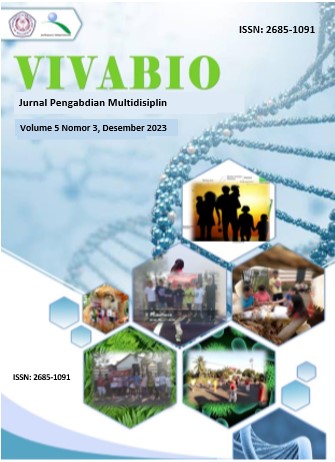Pemanfaatan Pati Sagu Menjadi Olahan Permen Sagu (Utilization Of Sago Starch Into Processed Sago Candy)
DOI:
https://doi.org/10.35799/vivabio.v5i3.48708Abstract
Utilization of sago starch into processed Sago candy. The aim of the student creativity program – entrepreneurship (PKM-K) is to motivate students to become entrepreneurs in processing sago starch into processed sago candy. The methods of implementing this program are input, process (production), output, and evaluation. The results of this program are input, conducting market surveys to determine market conditions. Then conducted interviews with five female students at the Muhammadiyah University of Palopo. Next is a feasibility study of the business to be run. The last stage is the selection of materials and the provision of places as well as facilities and infrastructure to support the production process. Process (production), the process of making sago candy starting from the preparation of materials and tools until the sago candy is ready to be marketed. Output, namely sago candy crafts that are ready to be used and marketed to consumers. The last is evaluation, namely this stage is carried out when the production of sago candy products has been completed. At this stage, we will review any deficiencies that make consumers uncomfortable consuming our products. The conclusion of the PKM-K program is that using sago starch into processed candies that are worth selling can provide skills to students to remain innovative and creative in processing sago starch, provide opportunities for students to practice entrepreneurship with a comprehensive understanding of entrepreneurial concepts, and build student enthusiasm to stay in business.
Keywords: Entrepreneurship; sago starch; candy making.
ABSTRAK
Pemanfaatan pati sagu menjadi olahan permen Sagu. Tujuan program kreativitas mahasiswa – kewirausahaan (PKM-K) adalah membangkitkan motivasi mahasiswa untuk berwirausaha dalam mengolah pati sagu menjadi olahan permen sagu. Metode pelaksanaan program ini adalah input, proses (produksi), output, dan evaluasi. Hasil program ini adalah input, melakukan survei pasar untuk mengetahui kondisi pasar. Selanjutnya melakukan wawancara kepada lima mahasiswi di lingkungan Universitas Muhammadiyah Palopo. Selanjutnya adalah studi kelayakan terhadap usaha yang akan dijalankan. Tahap terakhir adalah pemilihan bahan dan penyediaan tempat serta sarana dan prasarana untuk menunjang proses produksi. Proses (produksi), proses pembuatan permen sagu mulai dari persiapan bahan dan alat sampai permen sagu siap dipasarkan. Output, yaitu hasil kerajinan permen sagu yang siap digunakan dan dipasarkan kepada konsumen. Yang terakhir adalah evaluasi, yaitu tahapan ini dilaksanakan pada saat produksi produk permen sagu telah selesai dilakukan. Pada tahap ini akan meninjau tentang kekurangan- kekurangan apa saja yang membuat konsumen tidak nyaman mengonsumsi produk kami. Kesimpulan program PKM-K pemanfaatan pati sagu menjadi olahan permen yang bernilai jual dapat memberikan keterampilan kepada mahasiswa untuk tetap inovatif dan kreatif dalam mengolah pati sagu, memberikan kesempatan kepada mahasiswa untuk praktik wirausaha dengan pemahaman konsep wirausaha yang komprehensif, dan membangun semangat mahasiswa untuk tetap berbisnis.
References
Gunawan, Y. (2022). Analisis Pengaruh Ukuran Diameter Serat Tangkai Sagu Terhadap Sifat Mekanik Pada Material Komposit. 2.
Higiene, S., Ukm, D. I., & Sagu, P. (2022). Peningkatan Pengetahuan Dan Kesadaran Penerapan. 3(1), 242–
Jong, F. S., & Selatan, S. (2007). Sagu: Potensi Besar Pertanian Indonesia. 2(1), 54–65.
Karakteristik hidrologi, sifat kimia tanah dan morfologi sagu pada area rencana. (2018).
Kaya, A. O. W., Pattimura, U., Jl, A., Soplanit, C., & Ambon, P. (2020).
Karakteristik Produk Gel Kombinasi Karaginan Dan Characteristics Of Gel Product Combination From Carragennan
Moniharapon, A. (2016). Effect of Modified Sago Starch Concentration Oncandy Making. Jurnal Penelitian Teknologi Industri, 8(Juni), 49–56.
Munarso, S. J. (2005). Kajian terhadap sni mutu pati sagu. November. https://doi.org/10.31153/js.v7i3.34
Pengajar, S., Studi, P., Pertanian, F., & Raya, U. P. (2018). Mengembangkan Agribisnis Skala Rumah Tangga. 13(2), 59–70.
Perencanaan, B., & Daerah, P. (n.d.). BAGI. 73– 82.
Pratiwi, Y. E., & Hartono, Y. D. (2022).
Efektivitas Limbah Serat Batang Sagu dalam Mengurangi Kadar Besi ( Fe ) pada Air Sumur. Jurnal Inovasi Sains Dan Teknologi (INSTEK), 5(2), 13–18.
https://doi.org/10.51454/instek.v5i2.728
Rahmawati, S., Wahyuni, S., Khaeruni, A., Ilmu dan Teknologi Pangan, J., Pertanian, F., Halu Oleo, U., & Jurusan Hama dan Penyakit Tanaman, K. (2019). Pengaruh Modifikasi terhadap Karakteristik Kimia
Tepung Sagu Termodifikasi : Studi Kepustakaan The Effect of Modification Process on the Chemical Characteristics of Modified Sago Flour: A Review. J. Sains Dan Teknologi Pangan, 4(2), 2096–2103.
Studi, P., Industri, T., Kimia, D., & Industri, D.
T. (2019). Stabilitas Edible. 29(2), 278– 289. https://doi.org/10.24961/j.tek.ind.pert.2019
.29.3.278
Sutanto, E. D. I., Sahan, Y., & Octavia, D. (2014). [ CONVERSION SAGO STARCH TO GLUCOSE SYRUP BY USING HYDRO CHLORIDE ACID S A CATALYST ] Laboratorium Teknik Reaksi Kimia. 13(1), 22–28.
Syarif, F. B. . R. F. . Z. Y. (2019). 7863-17604-
-SM alga bakteri. Pemanfaatan Simbiosis Mikroalga Chlorella Sp Dan Agrobost Untuk Menurunkan Kadar Polutan Limbah Cair Sagu, 18(1), 9–16.
Widiarto, E., Fidyasari, A., & Kg, R. (2017).
Produksi Glukosa Cair Dan Karakterisasi Tepung Jagung , Tepung Sagu dan Larutan tepung dimasukan dalam reaktor jetcooker 5, 1213–121
Downloads
Published
How to Cite
Issue
Section
License
Copyright (c) 2023 Authors

This work is licensed under a Creative Commons Attribution-ShareAlike 4.0 International License.



